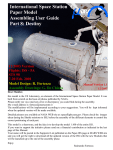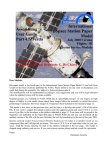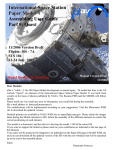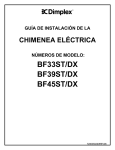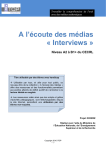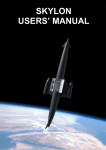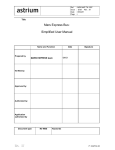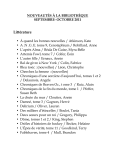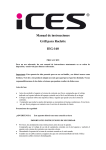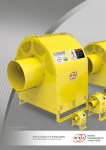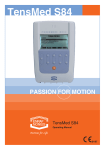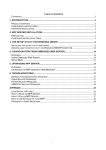Download International Space Station Paper Model Assembling User Guide
Transcript
Assembling User Guide Part 7: P6 Model Design: R. Fortezza International Space Station Paper Model November 2000 Version Flights: 4A STS - 97 Assembling Manual Drawings: G. De Chiara Dear Modeler, this paper model is a part of the International Space Station Paper Model. It has been built from scratch on the basis of photos published by NASA. Please notify to me any error or discrepancy you could find during the assembly. My e-mail is: [email protected]. The modifications will be implemented according to your suggestions and you will be kept informed when the updated version will be made available. Detailed pictures are available at NASA WEB site at: speceflight.nasa.gov. If you require an high degree of fidelity in your model, please check these images before the assembly to control the correct positioning of each part. However, drawings of ISS P6 elements have been included in this manual. These models should be considered as a shareware, as the previous ones, and the idea is to develop the model 1:100 and 1:144 of the entire ISS. If you want to support the initiative please joint the supporter group and send a financial support to the developer at the address indicated in the last page. Your name will be posted in the Supporter list published on the Paper-ISS page at MARS WEB site and you can download all the updated version of the ISS with the new Modules that will be launched up to the end of the year 2001. High-quality printed model (Unity+Zarya+Shuttle Endeavour+Zvezda+Soyuz+Progress+Z1+P6 and related manuals) is available based on un-compressed files and original sheets printed with 1440 dpi inkjet printer. If you are interested please send me a request via e-mail. I’ll provide you the cost and time estimation. Send the money directly via mail to the address indicated at the last page. The model is shipped using ordinary post service. If you want express courier please specify it in your request. Enjoy Raimondo Fortezza P6 Assembling Guide P6 Element should be mounted in this phase above the Z1. The P6 is formed by 9 Sheets: 4 printed on glossy paper sheets, 4 cardboard (Photo paper) sheets and 1 transparent. For your help, make also a b/w copy of each sheet so that you can have the labels, the parts numbers and other indication as reference guide also when the sheets are cut. In addition to scissor, glue, rulers, cutters and all the common modelers tools, to mount the huge photovoltaic panels you need two square section stick 7x7 and 6x6 mm to easy the gluing of the telescopic boom (the material is not important). The length of the sticks should be 25 cm (10“). For the 1:144 model you need 5 x 5 and 4 x 4 stick. The P6 will be relocated in the future to form part of the ISS main truss, that in scale 1:100 will be longer than 1 meter. For this reason the P6 element is really stiff and requires the use of thick cardboard. All the part included in a red dashed rectangles should be glued on this thick cardboard. A tick cardboard sheet is available in each pack of Epson quality paper and it is suitable as well as any cardboard with a thickness in the range 0.7-0.8 mm (if you use thicker paper, the elements do not fit). Cut out and bend the parts following the lines. For best results use a sharp hobby knife and a metal straight edge. For some parts small scissor (normal and curved) is better. Glue together the parts using a thin, even coat of ordinary white glue or the new transparent gel glue. The P6 starts from the four Solar Print the sheets on a color #43 Panels mounted in couple. The printer. The format of this #43 Photovoltaic (PV) Panels are model should be compatilong about 35 cm each and canble with both A-4 or US not enter entirely in an A4 sheet. Letter sheets size. Images For this reason each PV has been of real elements have #74 cut in several parts. The same been included in this approach has been used for the manual to help #47 telescopic boom. Print on glossy you during #44 #47 paper the sheets PV 2, 3 , 4, and assembly. #75 #44 5. The sheets 2 & 3 are the same sheet so you shall print two copy of it. The same concept applies to sheets 4-5 and 7-8. #46 Cut the parts #44,#48 and #45 representing the solar panels. Print the sheets 7&8 #76 #46 on cardboard (for instance Epson Photo #48 paper). Cut the #74 and #73 and glue #73 them on the previous elements. Glue also #48 the back side of the panel formed by the parts #43, #47 and #46. Try to align each part carefully before to glue them. Leave the glue dry by keeping the part under weight or inside a large book so that the panel stay flat. #45 Cut also the central parts #75, #76 and form another solar panels. At the end you should form 4 different solar panels. #45 Please note that each panel is not fully symmetric, but an edge is flat and is the internal one (close to the boom), while the other is formed by a raw of “teeth” and is the external one. page 2 Cut #77 Cut the other parts from sheets 7 & 8, and glue them on a thick cardboard. I used the Cardboard sheet included in each pack of Epson quality paper as bending protection. It is about 0.7 mm thick. Cut all the parts from #77 to #91. Please consider that in this block part #89 is the only one that shall not be glued on the cardboard. All the part indicated with a red capital R surrounded by a circle R has to be removed. Glue on Cardboard Glue back to back the panel supports parts #77 and #78. The two squared areas have to be removed. Cut also all the four small rectangles as indicated in the figure. Do the same with parts #79 and #80. Keep aligned the two parts and the four small slots during gluing. Cut and glue the three #87 squares as a #86 stack. On the top glue the part #86. At the end you should #87 #78 mount two different couples of supports. Now you should start to mount the telescopic boom used to #79 extend the solar panel. The boom shall be printed on a transparent sheet. The first boom is formed by the three different parts #92, #93 and #94. The second boom with #95, #80 #96 and #97. I used a plastic stick with square section of 7 x 7 mm as support during the gluing phase. Use a sharp knife on the not-printed side to engrave the bending lines. The external side is the printed one. The glue has to be distributed on the clear side and distributed uniformly on the entire side. Use transparent glue for the boom. During the glue drying use clips to keep the surfaces pressed each other. Using the stick this operation is more easy and the glue form a thin transparent layer. page 3 Boom 1 #92 #96 #95 Glue first the section #92. Do the same with section #94. The two elements in reality are formed by very thin steel and carbon fiber structure. Since for the model we need a stiff structure the transparent sheet has been selected as the more realistic approach. Try to glue carefully so that the structure stay more transparent as possible. Use the second stick 6 x 6 mm to glue part #93. Once the three #93 parts are dried glue them together. The part red of #92 is one tip. The other tip is indicated on the side of part #94. The element #93 has to be glued inside and in the middle of #94 the boom. Pay attention to distribute the glue uniformly on the #93 before to insert it in the #92 and #94. #97 Boom 2 Once the boom is dry, insert it in the #79-80. The tip has to be inserted in the stacked squares. Take also two solar panels. Put the blue side of the panel as indicated in the drawing below and the “teeth” edge external. The four stripes have to be inserted in the four slots of the supports. Once in place, you shall glue the stripes on both side of the support and let them dry. teeth Yellow side teeth Blue side Once the elements are dried insert the boom also on the other support #77-78. The red part has to pass through the squared hole of the support. The four stripes of the PV panel have to be inserted in the four slots of the supports and the two panels have to be kept tight between the two supports. Use a pair of tweets to pull the strips and align the solar panel. Cut the cardboard reinforced parts #81, #82, #83 and #84. Insert them in the boom tip and glue them on each red stripe. Read the next page to check the distance between the four disks. page 4 For a better realism I designed also the rotating mechanism for the beta joint, so that the panels can be oriented toward the sun. You need a wooden stick with a diameter of 3 mm and a length of 4.5 mm (for the 1:144 model use a 2 mm one for a length of 3.2 mm). Cut the four reinforced squared parts #88. Cut an hole in the center of each part and insert each of them in the stick. The distance of the disks and of the squares in indicated in the drawings. Before glue disks and squares check how they fit on the boom and adjust accordingly. 5 10 5 16 Boom Disks Stick 5 14 10 45 mm Squares Cut, fold and glue the four panel containers #49, #50,#51 and #52. You need two set of them. The container has two open areas in the base to allow the stripes of the solar panel protruding from the support to stay inside the box. Glue a couple of containers on each panel support. The two photovoltaic panels are ready!! Cut the supports of the boom canister #90 from sheets 7 & 8. Glue them on the cardboard and let them dry flat under a weight. Cut carefully with a cutter from the cardboard including the long horizontal slots located on both side in the middle. page 5 Prepare the boom canister support #90. It has been reinforced with cardboard. Cut and bend has indicated in the drawing. 1 Remove the circle from the support. Flip first the left and right part to the internal side. Do the same with the lower part; then the lower part has to be bent and inserted inside. Follow the drawing for a better understanding. Be aware that this part has to be very stiff because it has to sustain the entire weight of the Photovoltaic Panel 2 3 Cut also the part #89 and #91 reinforced. Insert the #91 inside the #89 as depicted in the left drawing. Flip the three rectangles around the circle forward; flip the other walls backward. Be aware that, once the glue is dry, you have to remove a 3 mm diameter disk in the center. Glue together the part #89 and #90 by inserting the #89 inside the #90. This part is not very realistic simply because the real canister does not support the weight of the solar panel (the gravity force on the ISS is less than 1 millionth respect to earth - this environment is called microgravity). However the shape of this part is not so bad and I hope that also the purists can accept it (it is also slightly larger than reality). page 6 #58 #59 1 #90 2 3 #59 #89 #40 #40 side Roll the canister #59 (two of them are needed). Try to distribute uniformly the glue on the entire white part with red spots, so that the cylinder become stiff and rigid. Once mounted, bend the gluing tabs and check how it fits inside the support. Once it enter exactly inside the hole, glue in place considering that the harness and the gluing rectangle are located on the upper part. Bend the part #58 and glue inside the cavity. Once both supports are ready glue them on the part #40 reinforced with three different layers of cardboard to avoid the torsion caused by the not symmetric geometry of the panels. Once the 3 layers are dried, glue around the #40, the belt “ #40 side”. Use clips to ensure good gluing and contact between the layers dry. At this stage you can insert the PV panels in the canisters and fit on place by using the three rings #85 closed by the #85b. Note that probably it is better to glue the base and the canisters on the main body of P6 before insert the two PVs in the Canisters. If you plan to keep mounted the PV panels all time suspend them with a line of nylon glued at the tips to reduce the load on the canisters. Glue the disk carefully to avoid that glue in excess could prevent the rotation of the PV. page 7 Start to mount the three radiators. Cut the various elements from sheet 6 and glue on the cardboard the elements surrounded by the dashed red lines. Cut and fold the three boxes #69, #70 and #71. Glue them in the center of the radiator plates #66, #67 and #68 that need to be reinforced with cardboard. Glue back to back the radiators #60 and #61. Pay attention to align them carefully. The gray part with small strips shall not be glued. Repeat the procedure for the other two radiators #62-63 and #64-65 Radiator Plate #66,#67, #68 Extensors (2 x Radiator) Radiator Box #69,#70,#71 Bend each radiator so that it is shaped in the same way that the extensor #72 that are here illustrated to be used as reference for the bending angles. Use two rulers to bend each panel of the radiator. Cut the reinforced extensors #72 with a cutter. Cut carefully avoiding to bend them once cut. The gray part should stay as external side. Pay attention that the extensors have two different shape since one has to be mounted above and the other below the radiator. Attach the radiator to the box by gluing the gray tab and stick to the box side. page 8 Once mounted each radiator has to be shaped like the drawing on the right. You need to mount three of them to be attached to the P6. Fold and mount the box #14. Glue it on the plate #12 reinforced with cardboard. Fold and mount the support #35 and #36. Glue on the tip the half circle #31 and a small steel wire in the center. Fold and mount the support #56 formed by gluing back to back the reinforced parts #56 and the surrounding belt # 5 3 . D o t h e Roll and glue same with parts the tube #55 (three of them are #57. needed, one is spare). Each tube has to be cut for the needed length. Fold and mount the keel support #23 and #24 and the internal and the surrounding belts #26 and #25. Glue on the tip a small piece of steel wire in the center. Support #56 Tube #55 #32 Glue the tube to the supports and cut of the right length. Glue on the tip the half disk #32 and a small piece of steel wire. Repeat the procedure for #57. Fold and mount the keel support #21, #22 and the surrounding belt #27. Glue on the tip a small piece of steel wire in the center. page 9 Picture of the P6 during integration at Kennedy Space Flight Center. The P6 is formed by the Long Spacer (left part) and the Integrated Equipment Assembly - IEA right part. The side shown is the forward. please note the position of all the target to be placed on the model. If you want to improve the realism note the sort of pocket located in the central part of the covering blanket. The support you can see is the #56 and you can understand how to mount the tube #55. In the lower side of the structure are located the two keel fixations #22 and #23 with the protruding steel rod . Picture of the P6 in the integration hall at KSC suspended over the MPLM. The side shown is the aft. Please note the position of all the target to be placed on the model. The support you can see is the #57 and you can understand how to mount the tube #55 and the grabble fixture for the Shuttle Remote Manipulator System. In the lower side of the structure you can see the keel fixation #22 with the steel rod protruding and the two target (note that one is mounted at 90° respect the other. Mount the movable grabble fixture formed by part #39 to be fold and glued and #41 simply reinforced with cardboard. Over it can mount on it the last grabble fixture #38 installed there during a recent flight page 10 As final step we need to build the main body of P6 formed by IEA and the Long Spacer. We start from the base #8 reinforced with cardboard on which, to improve the stiffness, you should glue the four triangular supports #42. Please consider that the printed part is the external one and that the triangles should be mount on the other side. Do the same with the other plate #9, #10 and #11. As already explained the P6 has been designed to be very stiff to sustain the bending load once it form the ISS structure long more than 1 meter. Note that the forward and aft panels are formed by two separate parts, while port and starboard is formed by a continuous panel. All the panels and the bases need to be reinforced with cardboard. Glue them under a weight to keep them perfectly flat. On the starboard and port panels there are two slot needed to fix the #9 and #10 bases. To improve the realism try to cut the slot only on the cardboard and not on the colored external sheet. Make a test with all the part in the right place without glue to check how they fit. Please consider that each base has different joints for each panel so that its correct position is unique. Additional drawing have been add at the end of this manual to check the position of small parts. Once glued try to use clips, rubber bend or other systems to leave all the element in place during the glue drying. The part #13 and #7 are not reinforced, but has to be glued on the upper and lower base at the end of this assembly. These elements will not be visible, since the base will be glued to Z1 and #13 will be covered by #40, however they have been included bur a great realism. #13 #11 #3 #6 #4 #10 #1 #9 #5 #2 #8 #7 page 11 Now, the final effort !! Glue the PV boom canister base over the P6 main body. Glue all the three radiators in place. Attach also the large box #12-14, the small box #15 over its base #16 (reinforced) and the two boxes #17 and #18. The Boxes #28, #29 and #30 have to be mounted close to each radiator in their specific gluing boxes. Mount also all the target and the the grabble fixtures on the modules. The supports #35 and #57 are mounted on the Forward panel. The support #36 and #56 on the Aft panel. At the end you should have only few unused parts: #53, #54, #55, #56 and #57 that are spare ! Now you can glue the entire P6 over the Z1, where it will stay until it will be relocated to form the ISS main truss. Congratulation, you finished your P6 element !! If you enjoyed and if you like your new updated ISS Paper Model, why don't joint the ISS Paper Model Supporter group by providing a small financial help to the designer? Consider that I spent more than 100 hours only to design the P6, to test it and to write this manual !! For further info read the web page: http://www.marscenter.it/iss/paper_iss_model.html Please send your financial contribution in your national currency in a closed envelop directly to: Raimondo Fortezza Via A. Falcone, 58 I-80127 Naples Italy Thanks !! page 12 page 13 page 14














